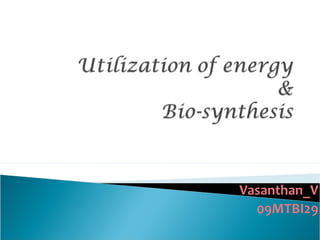
Microbiology
- 2. • Energy is stored in the form of high-energy-transfer compounds(of which ATP is most imp..). • The principle of coupling exergonic reactions to endergonic reactions requires the utilization of high-energy-transfer compounds like ATP. • An electrochemical proton gradient may result in ATP synthesis,but it can also be used for other biological purposes like generating heat and rotation of bacterial flagella.
- 3. • In cell biosynthetic processes requires energy. • Energy from ATP is used to convert one chemical substance into another and to synthesize complex substances from simpler ones.
- 4. Synthesis of small molecules: THE AMINO ACIDS Synthesis of macro molecules: THE STRUCTURE AND BIOSYNTHESIS OF A CELL WALL PEPTIDOGLYCAN THE BIOSYNTHSIS OF DNA(DeoxyriboNucleicAcid) PROCESS OF PROTEIN SYNTHESIS
- 5. • Amino acids,of which there are about 20,are the building blocks of proteins. • The sequence & manner in which in which they are linked determine the type of protein they form. • A microorganism growing in a medium may have all 20 of amino acids present in the medium;that is ,they are available for the microbe,performmed in the medium. • If they are not available freely in the medium,the microorganism may have to liberate amino acids from proteins by the action of intracellular or extracellular proteolytic enzymes.
- 10. • In cell,major end prodts of biosynthesis are proteins and nucleic acids. • However, they are macromolecular peculiar to the prokaryotes which require specialized biosynthetic processess. • This also serves as a example of how polymers are synthesized outside the membrane.
- 11. • Rigid wall of cell wall structure is Murein Peptidoglycan Mucopeptide. Walls of gram +ve bacteria contains large amount of peptidoglycan. Gram –ve has smaller proportion. Peptidoglycan has three buliding blocks Acetylglycosamine(AGA or GlcNAc) Acrtylmuramic acid(AMA or MurNAc) A peptide containing of 4 or 5 amino acids of limited varity.
- 15. • E.coli can synthesize cell-wall peptidoglycan when grown in a simple medium of glucose, Ammonium sulfate,and mineral salts.
- 18. Precursors synthesised in the bacterial cell • Lipid carrier – bactoprenol essential role – Very hydrophobic C55 alcohol – Bonds to N-acetyl glucosamine/N-acetyl muramic acid/pentapeptide peptidoglycan precursors – Transports precursors across the cytoplasmic membrane by rendering them hydrophobic enough to pass through – Once in periplasm bactoprenol interacts with that insert cell wall precursors into the growing point of the cell wall and catalyse glycosidic bond formation
- 19. • Final step in peptidoglycan synthesis • Involves formation of peptide cross-links between muramic acid residues in adjacent chains • 'penicillin-binding proteins' in the outer leaf of the cell membrane responsible for this step – enzymes responsible for the final stages of assembly of the peptidoglycan molecule – up to 4 in Gram positive bacteria, up to 11 in Gram negative bacteria – PBPs use a serine containing molecule to bond covalently with the peptidoglycan chains
- 20. • Another DNA is a template; in the biosynthesis of protein molecule of RNA is the template. STUCTURE OF DNA DNA from any cell is a long rope like molecule compossed of 2 strands,wound to form double helix. Proposed by james watson & francis crick.
- 22. DNA NUCLEOTIDES NUCLEOSIDES PHOSPHORIC ACID PURINE BASE PYRIMIDINE BASE SUGAR (ADENINE, (CYTOSINE, (2-DEOXY GUANINE) THYMINE) RIBOSE)
